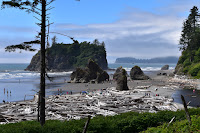 |
| Ruby Beach - Washington coast |
We made a trip into
Seattle to visit friends and made a visit to the
Klondike Gold Rush National Historical Park near
Jackson Square. This little museum tells about the gold rush in a way that is easy to understand and keeps you interested as you walk around. Why is it in
Seattle? Because
Seattle was the only hub to get supplies and transportation to the Klondike Gold Rush area. You might say the gold rush is what made
Seattle a major city.
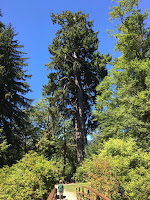 |
Worlds largest Spruce Tree
at Quinault Lake |
We spent most of the month of July on the coast of
Washington. The first
home base was
Copalis
Beach where we were a 10
minute walk to the shore. The wind never stopped and it was cloudy most of the
time. There were a few times when the wind was lighter and we walked or rode
our bikes on the beach. We used this location to explore the west side of the Olympic peninsula up to
Ruby Beach and
Quinault Lake in Olympic
National Park. This side of the
National Park is a rain forest so the forest is
extremely dense and there are huge trees, including some record breakers. We
explored the coast from
Ocean Shores to
Ruby
Beach checking out all
the little coastal towns and state parks.
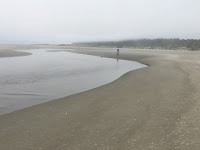 |
| Riding bike on beach at Copalis Beach |
Our next move was to Ilwaco, WA at the southwest tip of the state near the Columbia River. We were a couple miles off of the ocean coast and half a mile from the river. We explored up the coast to the
famous Long Beach where it was crowded but spent most of our time exploring
historical sites along the river. There is a lot of history about Lewis and Clark, early inhabitants and exploration in
the area, the history of shipping and fishing in the area, the amazing
treacherous mouth of the river and its claiming over a thousand ships over the
last two hundred years, and the Forts that protected the mouth of the Columbia
through World War II. It was a busy and fun two weeks exploring this area which was a split between Washington and Oregon on both sides of the
river.
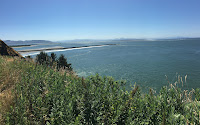 |
Where the Columbia River meets
the Pacific Ocean. This is huge, five
miles across the river so this is a
panoramic pic from the Cape
Disappointment Lighthouse |
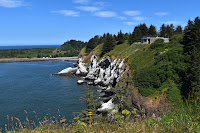 |
Lewis & Clark Interpretive Center
from the Cape Disappointment
Lighthouse |
We saw lots of great things so I'll just give some brief highlights of our favorite sites.
First, if you look back at the history
of this blog you'll see us going to a lot of Lewis and Clark (Corp of
Discovery) sites and recommending the book Undaunted Courage. Coming to this
area to see where they finally arrived, explored, and spent the winter was
fantastic. There is a great
Lewis & Clark National Historical Park with a half dozen locations and
an
Interpretive Center that are great. The
Columbia River Maritime Museum
in
Astoria, OR is
fantastic, also with a lot of information on the history of the river.
Cape Disappointment State Park is a must see with the aforementioned
Interpretive Center
but also the light houses, beach, views and explanation of "Columbia River
Bar" and jetties. Great stuff.
Fort
Columbia was interesting
too.
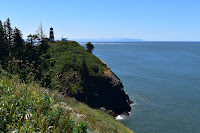 |
Cape Disappointment Lighthouse from
the Lewis & Clark Interpretive Center |
 |
| Fort Clatsop replica |
One last note, we drove down to Cannon Beach, OR
to check it out and see the famous Haystack Rock. Nice beach if you can handle
the relentless wind.
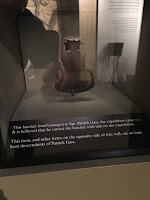 |
Hatchet head believed to be
used by Sgt Gass, the expedition
carpenter, on the expedition |
A comment on the pictures. The nice weather in the pictures is attributed to two things - they were taken in late July after the weather finally got nicer and we did our exploring with picture taking on nice days. Weather along the coast has a very large percentage of fog and clouds even in the summer.
